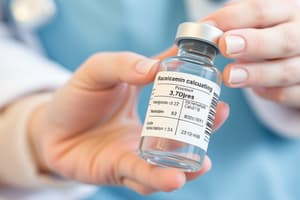Podcast
Questions and Answers
Which neural substrate affected by general anaesthetics is responsible for sedation and loss of consciousness?
Which neural substrate affected by general anaesthetics is responsible for sedation and loss of consciousness?
- Hippocampus
- Cerebral cortex
- Midbrain (correct)
- Thalamus
What is the main reason behind the prolonged after effects (hangover) of inhalational general anaesthetics?
What is the main reason behind the prolonged after effects (hangover) of inhalational general anaesthetics?
- Blood-gas partition coefficient
- High lipid solubility (correct)
- Low lipid solubility
- Alveolar ventilation rate
Which factor primarily determines the speed of induction and recovery from general anaesthesia?
Which factor primarily determines the speed of induction and recovery from general anaesthesia?
- Blood-gas partition coefficient (correct)
- Alveolar ventilation rate
- Oil-gas partition coefficient
- Body weight
Which site of action of general anaesthetics is associated with analgesia and pain relay?
Which site of action of general anaesthetics is associated with analgesia and pain relay?
Which characteristic adds flexibility and permits administration of lower doses of inhalational agents?
Which characteristic adds flexibility and permits administration of lower doses of inhalational agents?
What distinguishes parenteral drug classes from sedative drug classes in terms of administration?
What distinguishes parenteral drug classes from sedative drug classes in terms of administration?
Which receptors do Barbiturates and Benzodiazepines bind to?
Which receptors do Barbiturates and Benzodiazepines bind to?
What is the effect of GABA binding in the presence of Barbiturates and Benzodiazepines?
What is the effect of GABA binding in the presence of Barbiturates and Benzodiazepines?
Which drug can block the binding of Benzodiazepines to their receptors?
Which drug can block the binding of Benzodiazepines to their receptors?
At high doses, what additional receptors do Barbiturates block?
At high doses, what additional receptors do Barbiturates block?
What is the main use of Benzodiazepines in anesthesia?
What is the main use of Benzodiazepines in anesthesia?
Why do inhaled anesthetics have faster induction compared to other routes?
Why do inhaled anesthetics have faster induction compared to other routes?
Why does a less soluble general anesthetic equilibrate more quickly with blood and tissues like the brain?
Why does a less soluble general anesthetic equilibrate more quickly with blood and tissues like the brain?
What is the impact of faster ventilation rate on the equilibration/induction of anesthesia with general anesthetics?
What is the impact of faster ventilation rate on the equilibration/induction of anesthesia with general anesthetics?
Why does the onset of anesthesia appear slower with more soluble anesthetic gases like halothane compared to less soluble gases like nitrous oxide?
Why does the onset of anesthesia appear slower with more soluble anesthetic gases like halothane compared to less soluble gases like nitrous oxide?
Which anesthetic gas is relatively insoluble based on the blood:gas partition coefficient provided in the text?
Which anesthetic gas is relatively insoluble based on the blood:gas partition coefficient provided in the text?
What is indicated by the relative size of the blood compartment in the schematic diagram regarding solubility in blood?
What is indicated by the relative size of the blood compartment in the schematic diagram regarding solubility in blood?
Why does it take longer for the blood partial pressure of halothane to rise to the same level as in the alveoli compared to nitrous oxide?
Why does it take longer for the blood partial pressure of halothane to rise to the same level as in the alveoli compared to nitrous oxide?
Flashcards are hidden until you start studying



